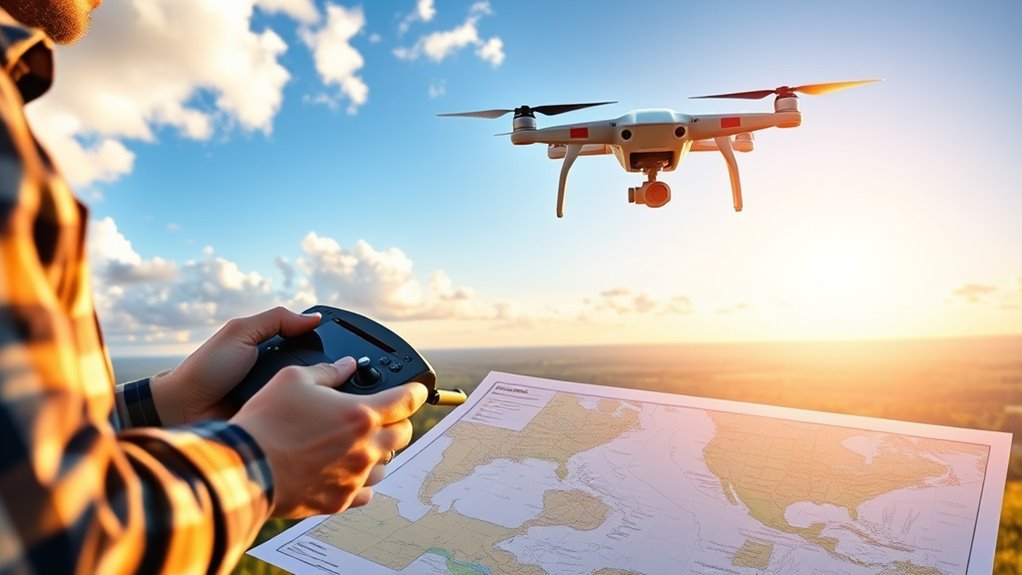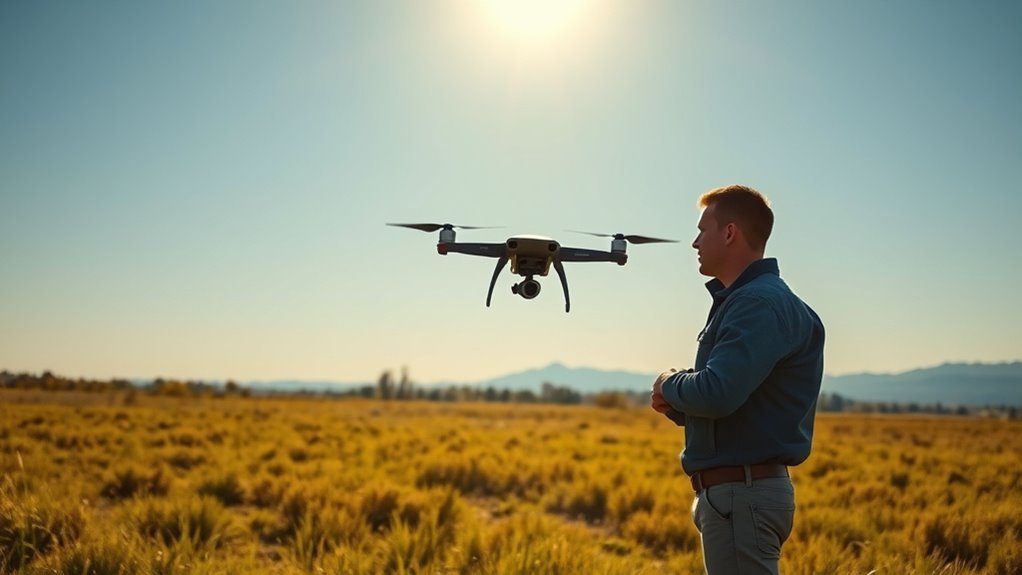To fly your drone safely and effectively, start by understanding airspace regulations and conducting thorough pre-flight checks. Verify your drone is in good condition and familiarize yourself with essential controls. Adopt best practices in aerial photography, maintaining distance from obstacles and people. Regularly maintain your equipment, including firmware updates, to enhance performance. Finally, prepare for emergencies by knowing your drone’s protocols. Keep following along to uncover more detailed strategies for successful drone operation.
Understanding Airspace Regulations

When you fly a drone, understanding airspace regulations is essential, as it not only guarantees safety but also compliance with legal requirements. Familiarizing yourself with airspace classifications helps you navigate where you can and can’t fly. The airspace is divided into various categories—Class A through Class G—each with specific rules. For instance, certain areas may be designated as no fly zones, such as near airports, military installations, or national parks, where drone operations are prohibited. Ignoring these restrictions can lead to serious legal consequences or accidents. By staying informed about airspace classifications and respecting no fly zones, you’ll enhance your freedom to explore the skies while ensuring a responsible and safe flying experience. Additionally, understanding radar detection factors can help you operate your drone more discreetly and avoid conflicts with manned aircraft. Furthermore, adhering to legal regulations regarding flight distance limits ensures that you remain compliant while enjoying your drone’s capabilities.
Pre-Flight Checklist

Having a solid understanding of airspace regulations sets the stage for responsible drone operation, but safety measures don’t end there. Before your flight, conduct a thorough pre-flight checklist. First, inspect your drone equipment for any damage or wear. Verify all components, such as propellers and batteries, are secure and functioning properly. Next, check the weather conditions; high winds, rain, or low visibility can greatly impact your flight’s safety. Always confirm that you have enough battery life for your intended flight duration and a buffer for safe return, as battery life and flight duration are critical for successful operations. Finally, familiarize yourself with the planned flight area, looking out for obstacles and no-fly zones. By adhering to this checklist, you enhance both your safety and the freedom to fly responsibly. Additionally, ensure that your drone is equipped with advanced GPS positioning to help maintain stable flight and avoid drift.
Essential Drone Controls and Features

Understanding the essential controls and features of your drone is vital for effective operation. You’ll want to familiarize yourself with basic drone controls, key safety features, and advanced flight modes that enhance your flying experience. Mastering these elements not only improves your skills but also guarantees safer flights. Additionally, integrating auto-stabilization and simplified controls can greatly ease the learning process for new pilots. For example, knowing the drone’s battery life and durability can help you plan your flights more effectively and avoid unexpected interruptions.
Basic Drone Controls
Mastering the basic controls of a drone is essential for both novice and experienced pilots alike. Understanding joystick sensitivity settings allows you to fine-tune your drone’s responsiveness, which is vital for effective maneuvering. Generally, the left joystick controls altitude and rotation, while the right joystick manages forward, backward, and lateral movement. Practice drone maneuvering techniques, like gentle ascents and descents, to gain confidence in handling your craft. Familiarize yourself with the return-to-home feature and other essential controls for emergencies. Adjusting the joystick sensitivity settings can help you find the perfect balance between precision and speed. Every pilot should invest time in mastering these basics, as they pave the way for more advanced flying skills and greater freedom in the skies.
Key Safety Features
Once you’re comfortable with the basic controls of your drone, it’s important to pay attention to its safety features, which are designed to protect both your investment and the environment around you. Key among these is collision avoidance technology, which uses sensors to detect obstacles and alter your drone’s flight path, helping you avoid accidents. Additionally, GPS accuracy is vital for precise positioning and return-to-home functions, ensuring your drone can navigate safely back to you even if it loses contact. By actively utilizing these features, you can enhance your flying experience while minimizing risks. Embracing these safety tools not only empowers you but also fosters responsible drone operation in shared airspace.
Advanced Flight Modes
As you explore the capabilities of your drone, you’ll find that advanced flight modes greatly enhance your flying experience and expand the range of creative possibilities. Waypoint navigation allows you to pre-program specific points for your drone to follow, enabling precise aerial shots without constant manual control. The Follow Me mode automatically tracks your movements, perfect for capturing dynamic footage while you’re on the move. Course lock keeps your drone oriented to a fixed direction, allowing for smooth, consistent shots even in challenging conditions. These intelligent flight modes empower you to focus on creativity, freeing you from the complexities of manual control. Mastering these features will greatly elevate your drone flying skills, revealing new perspectives and opportunities.
Best Practices for Aerial Photography
While capturing stunning aerial photographs can be exhilarating, adhering to best practices guarantees not only the quality of your images but also the safety of your drone operations. Start by mastering composition techniques; rule of thirds and leading lines can elevate your shots. Pay attention to lighting conditions—early morning or late afternoon often provides the best natural light. Avoid shooting directly into the sun to minimize glare and enhance detail. Additionally, always check weather conditions and maintain a safe distance from people and obstacles. Use your drone’s camera settings effectively, adjusting ISO and shutter speed for ideal results. Regularly monitor environmental exposure to ensure your drone’s components remain in optimal condition. Moreover, understanding your drone’s obstacle avoidance technology can greatly enhance your flying experience. Finally, practice regularly to refine your skills and develop an instinct for capturing breathtaking moments from above.
Tips for Maintaining Your Drone
To keep your drone in peak condition, regular battery checks are essential to guarantee reliable performance and longevity. Additionally, staying updated with firmware releases can enhance functionality and safety features. By prioritizing these maintenance tasks, you can prevent issues that could compromise your flying experience. Furthermore, ensure the integrity of sealing techniques to protect against moisture intrusion, which can negatively impact electronic components. Consider incorporating advanced capabilities into your drone’s setup to improve its operational efficiency.
Regular Battery Checks
Regular battery checks are essential for ensuring your drone operates at peak performance and longevity. To maintain ideal battery lifespan, you should routinely inspect battery health, including physical condition and charge cycles. Keeping an eye on voltage monitoring is vital; low voltage can lead to unexpected crashes or reduced flight time. Make it a habit to check the battery’s voltage before each flight and after long periods of inactivity. If you notice significant drops in voltage or swelling, consider replacing the battery. By implementing these regular checks, you not only enhance the reliability of your drone but also maximize your flying freedom, enabling you to capture stunning aerial views without interruption. Prioritize battery maintenance for a worry-free experience.
Firmware Updates Importance
Keeping your drone’s firmware updated is essential for peak performance and safety, as outdated software can lead to malfunctions or compatibility issues. Regular updates often include critical firmware improvements that enhance stability and functionality. By staying informed about update notifications, you can guarantee your drone operates smoothly and efficiently. Neglecting updates might not only limit your drone’s capabilities but also expose you to safety risks during flights. Make it a habit to check for updates frequently, and consider setting up automatic notifications if your drone supports it. This proactive approach empowers you to take full advantage of your drone’s features while minimizing potential problems. Ultimately, keeping your firmware updated is a simple yet effective way to enhance your flying experience.
Responding to Emergencies While Flying
While flying a drone can be an exhilarating experience, it’s essential to be prepared for emergencies that may arise unexpectedly. Familiarize yourself with emergency protocols specific to your drone model. In a crisis, staying calm is vital; assess the situation quickly and determine the best course of action. If you encounter signal loss or battery failure, initiate the drone’s return-to-home feature to mitigate risks. Having a crisis management plan in place can help you navigate unforeseen challenges effectively. Make sure you’ve practiced maneuvers in a safe environment so you can react instinctively. Remember, being proactive and informed not only protects your drone but also contributes to the safety of those around you, allowing you to enjoy the freedom of flying without unnecessary worry. Additionally, understanding your drone’s flight time and battery performance can help you plan your flight sessions more effectively and reduce the likelihood of emergencies related to power loss. Moreover, being aware of signal strength and communication limits can enhance your ability to maintain control over your drone, especially in challenging environments.
Frequently Asked Questions
What Is the Best Time of Day to Fly a Drone?
The best time to fly a drone is during morning flights or when evening light softens shadows. These times provide ideal visibility and less wind, enhancing your freedom to capture stunning aerial footage with precision.
Can I Fly a Drone Indoors Safely?
While it’s tempting to explore indoor flying, you must consider indoor regulations and drone safety. Guarantee adequate space, avoid obstacles, and maintain control to enjoy the freedom of flight without compromising safety or causing disruption.
How Do Weather Conditions Affect Drone Flight?
Weather conditions greatly impact your drone flight. Wind effects can cause instability, while temperature impact affects battery performance and motor efficiency. Understanding these factors helps you make informed decisions for ideal flying conditions and experiences.
Are There Specific Places I Should Avoid Flying?
When you soar through the sky, remember to avoid no fly zones like airports and restricted areas. Likewise, steer clear of wildlife areas, ensuring both your drone’s freedom and the safety of nature’s inhabitants.
What Should I Do if My Drone Loses Connection?
If your drone loses connection, immediately initiate connection recovery protocols. Check for signal interference from nearby objects or devices. If necessary, regain control by using the drone’s failsafe mode to return it safely.

